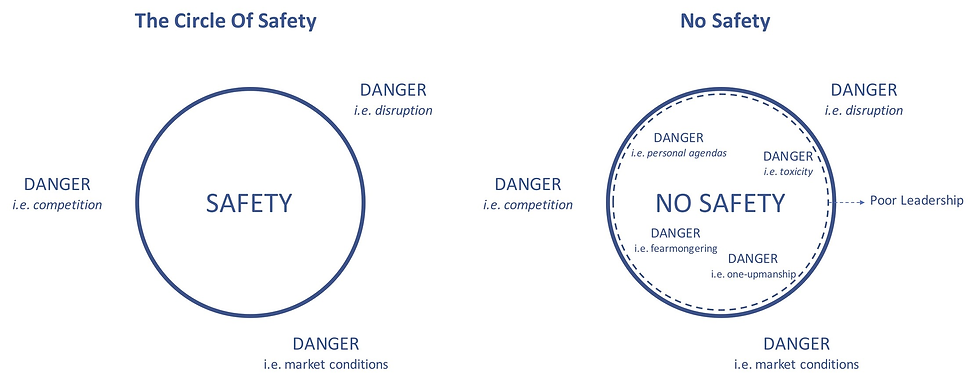Why Good Leaders Let Their People Eat First
- kristian8120

- Sep 8
- 3 min read
Updated: Sep 9

Have you ever worked on a team where you felt completely safe, supported, and trusted? A team where you knew your leader and colleagues had your back, no matter what? This sense of security is no accident; it's the result of a deliberate culture, and it's the core message of Simon Sinek's powerful book, Leaders Eat Last.
Sinek argues that the greatest organizations are not built on strength or authority alone, but on a "Circle of Safety" created by the leaders. This idea is rooted in our biology and evolution.
When we feel safe from threats, our bodies release oxytocin, the chemical responsible for trust and empathy.
When we feel threatened, we produce cortisol, which promotes self-preservation and fear.
The leader’s job is to manage the environment inside the organization so that people feel safe and can focus on the external threats, rather than fighting each other for resources or survival.

Here are a few key takeaways from Leaders Eat Last that explain how leaders can build this essential "Circle of Safety."
1. The Power of Empathy and Trust
Great leaders have a deep sense of empathy. They genuinely care about the well-being of their people and put their needs first. Sinek uses the powerful metaphor of a commander on the battlefield who ensures their soldiers are fed and rested before they are. This act of self-sacrifice, literally "eating last", builds deep-seated trust and loyalty. When employees feel that their leaders are sacrificing for them, they are more willing to sacrifice for the team and the organization.
2. The Dangers of Corporate "Abstraction"
One of the biggest threats to the "Circle of Safety" is what Sinek calls "abstraction." In a modern corporation, it’s easy for leaders to become disconnected from the day-to-day realities of their employees. When decisions are made based on abstract numbers and data points rather than on the real human impact, a sense of betrayal can set in. Leaders who know the names and stories of their people are far more likely to make decisions that prioritize their well-being, reinforcing the circle of safety.
3. Courage and Moral Rectitude
In a psychologically safe environment, individuals feel comfortable taking risks, being vulnerable, and offering new ideas without fear of being punished or shamed. The leader's courage to protect their people from internal threats, like office politics, fear of failure, and layoffs, is a foundational element of this safety. This moral rectitude from the top empowers everyone to do the right thing, not just the easy thing.
4. The Human Element
Sinek emphasizes that human connection is non-negotiable. Technology can enhance communication, but it can never replace face-to-face interactions, a shared meal, or a genuine conversation. The simple act of leaders spending time with their teams, asking questions, and listening actively builds the bonds that create a resilient, cohesive group.
When leaders prioritize the welfare of their team, a powerful transformation occurs. People stop looking out for themselves and start looking out for each other. They become more innovative, more productive, and more resilient.
The result is not just a successful organization but a place where people actually want to work.
Is your company a place where leaders eat last?
If you're looking to build a culture of trust and safety within your organization and need to prepare your leaders for this skills, book a consultation with us now.
ALVIGOR provides experiential workshops that don’t just teach these principles but also help you implement them.
.png)



Comments